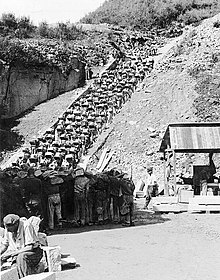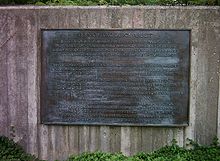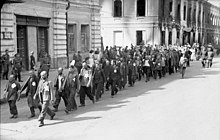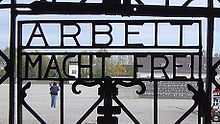Extermination through labour: Difference between revisions
Paul Siebert (talk | contribs) Reverted good faith edits by Hodja Nasreddin (talk): Rv the changes that have not been supported by consensus. Discuss on the talk page first. (TW) |
rv, sorry, but I can't see how a wholesale removal of various relevant authors like R. Medvedyev or scholars can be removed based on the personal perception of 2-3 wiki users |
||
| Line 51: | Line 51: | ||
Nazi Ideology demanded the "[[ethnic cleansing|purification]]" of the "Aryan race" and the "German blood" from "foreign-blooded people." These "foreign-blooded people" were principally Slavs, blacks, Jews, and parts of the gypsy population. Old people, sick people, "work refusers," so-called "asocials" and disabled people were considered "useless people." Regime opponents, such as communists, democrats and [[social democracy|social democrats]], were also persecuted, since they opposed the "decampment" and the "national awakening." |
Nazi Ideology demanded the "[[ethnic cleansing|purification]]" of the "Aryan race" and the "German blood" from "foreign-blooded people." These "foreign-blooded people" were principally Slavs, blacks, Jews, and parts of the gypsy population. Old people, sick people, "work refusers," so-called "asocials" and disabled people were considered "useless people." Regime opponents, such as communists, democrats and [[social democracy|social democrats]], were also persecuted, since they opposed the "decampment" and the "national awakening." |
||
== |
== Gulag == |
||
{{Main|GULAG}} |
{{Main|GULAG}} |
||
According to many authors, the deaths of [[Gulag]] prisoners were caused primarily by inhuman work conditions and starvation. Therefore, this could be described as "extermination through labor" <ref>[[Gunnar Heinsohn]] ''Lexikon der Völkermorde'', Rowohlt rororo 1998, ISBN 3-499-22338-4</ref><ref name="Joel Kotek / Pierre Rigoulot ''Gefangenschaft, Zwangsarbeit, Vernichtung''"> Joel Kotek / Pierre Rigoulot ''Gefangenschaft, Zwangsarbeit, Vernichtung'', Propyläen 2001</ref><ref name="Ralf Stettner 1996">Ralf Stettner ''Archipel Gulag. Stalins Zwangslager'', Schöningh 1996, ISBN 3-506-78754-3</ref><ref name="Roy Medwedew 1973">Roy Medwedew ''Die Wahrheit ist unsere Stärke. Geschichte und Folgen des Stalinismus'' (Ed. by David Joravsky and Georges Haupt), Fischer, Frankfurt/M. 1973, ISBN 3-10-050301-5</ref> For example, [[Roy Medvedev]] comments: "The penal system in the [[Kolyma]] and in the camps in the north was deliberately designed for the extermination of people."<ref name="Roy Medwedew 1973"/> [[Alexander Nikolaevich Yakovlev]] expands upon this, claiming that [[Joseph Stalin|Stalin]] was the "architect of the gulag system for totally destroying human life."<ref>[[Alexander Nikolaevich Yakovlev]]. ''A Century of Violence in Soviet Russia.'' [[Yale University Press]], 2002. ISBN 0-300-08760-8 [http://books.google.com/books?id=ChRk43tVxTwC&pg=PA15&dq=architect+of+the+gulag+system&lr=&ei=H860SrWnI4OAywTHjKyADw#v=onepage&q=architect%20of%20the%20gulag%20system&f=false p. 15]</ref>. |
|||
[[Alexander Solzhenitsyn]] introduced the expression ''camps of extermination by labor'' in [[The Gulag Archipelago]]. According to him, the system didn't exterminate opponents with poison gas, but rather let them work as prisoners on big building sites (for example the [[White Sea-Baltic Canal]], quarries, railroads, and urban development projects) under inhumane conditions. Prison conditions were generally characterized by: |
|||
According to formerly secret internal Gulag documents, some 1.6 million people must have died in the period between 1930 and 1956 in Soviet forced labor camps and colonies (excluding prisoner of war camps), though these figures only include the deaths in the colonies beginning in 1935. Some 900,000 of these deaths therefore fall between 1941 and 1945.<ref>A. I. Kokurin / N. V. Petrov (Ed.): ''GULAG (Glavnoe Upravlenie Lagerej): 1918–1960'' (Rossija. XX vek. Dokumenty), Moskva: Materik 2000, ISBN 5-85646-046-4, pp. 441-2</ref> |
|||
* very long working hours and high quotas (for example, , daily working quotas on the [[White Sea-Baltic Canal]] required prisoners to "break up two cubic meters of granite [by hand] and transport by wheelbarrow over a distance of one hundred meters"; in the Burepolom forced-labor camp, inmates had to cut as many as 7 cords of wood per day and drag them to the shipping point; in the [[Kolyma]] camps, a typical quota was 800 [[pood]]s/12.8 [[metric tonnes]] of ore mined underground, often in freezing conditions)<ref>[[Alexander Solzhenitsyn]] ''Arkhipelag Gulag'', Vol. 2. "Novyy Mir," 1990. P. 63, 131-132</ref> |
|||
* starvation rations (300 grams of bread was a typical daily ration<ref>[[Alexander Solzhenitsyn]] ''Arkhipelag Gulag'', Vol. 2. "Novyy Mir," 1990. P. 75, 133-134</ref>), which were further reduced if quotas were not met |
|||
* icy cold, often with completely inadequate clothing (inmates often had to make their own "shoes" from discarded rubber tires or pieces of old winter coats)<ref>[[Alexander Solzhenitsyn]] ''Arkhipelag Gulag'', Vol. 2. "Novyy Mir," 1990. P. 28, 135-136</ref> |
|||
* disease (e.g. [[typhoid fever]], [[scurvy]], [[pellagra]], [[kwashiorkor]], [[dystrophy]], and many other deadly diseases), with inadequate medical care<ref>[[Alexander Solzhenitsyn]] ''Arkhipelag Gulag'', Vol. 2. "Novyy Mir," 1990. P. 37-39, 138-139, 142-144</ref> |
|||
* filth, vermin, insufficient hygienic supplies, particularly in the women's camps |
|||
* drastic punishments for even the slightest infraction, harassment, insults, and abuse.<ref>[[Alexander Solzhenitsyn]] ''Arkhipelag Gulag'', Vol. 2. "Novyy Mir," 1990. P. 28-29, 83-84, 90</ref> |
|||
*arbitrary executions and mass murder of prisoners<ref>[[Alexander Solzhenitsyn]] ''Arkhipelag Gulag'', Vol. 2. "Novyy Mir," 1990. P. 40, 45-46, 84-86, 134</ref> |
|||
Similar in its cynicism to the motto "[[Arbeit macht frei]]," which was affixed to the entrance of various Nazi concentration camps (Dachau, Sachsenhausen, Auschwitz, among others), the phrase "let us drive mankind to happiness with an iron hand," was already prominently displayed over the first large Soviet forced labor camp in the year 1923.<ref>Source: M. Stark, Frauen im Gulag, Deutscher Taschenbuchverlag, 2005</ref> |
|||
These figures are consistent with the archived documents that Russian historian [[Oleg Khlevniuk]] presents and analyzes in his study ''The History of the Gulag: From Collectivization to the Great Terror'', according to which some 500,000 people died in the camps and colonies from 1930 to 1941.<ref>Oleg V. Khlevniuk: ''The History of the Gulag: From Collectivization to the Great Terror'' New Haven: Yale University Press 2004, ISBN 0-300-09284-9, pp. 326-7.</ref> Khlevniuk points out that these figures don't take into account any deaths that occurred during transport.<ref>ibd., pp. 308-6.</ref> Also excluded are those who died shortly after their release due to the harsh treatment in the camps,<ref>Ellman, Michael. ''[http://sovietinfo.tripod.com/ELM-Repression_Statistics.pdf Soviet Repression Statistics: Some Comments]'' Europe-Asia Studies. Vol 54, No. 7, 2002, 1151-1172</ref> who, according to both archives and memoirs, were numerous.<ref>[[Anne Applebaum|Applebaum, Anne]] (2003) ''[[Gulag: A History]].'' [[Doubleday (publisher)|Doubleday]]. ISBN 0767900561 pg 583</ref> The historian J. Otto Pohl estimates that some 2,749,163 prisoners perished in the labor camps, colonies and special settlements, although stresses that this is an incomplete figure.<ref>Pohl, ''The Stalinist Penal System'', p. 131.</ref> |
|||
[[Gunnar Heinsohn]], sociologist and professor in [[Bremen]], expressed the view that "extermination through labor in the twentieth century was a critical method of extermination for Marxist-Leninist regimes."<ref>[[Gunnar Heinsohn]] ''Lexikon der Völkermorde'', Rowohlt rororo 1998, ISBN 3-499-22338-4</ref>. Joel Kotek and Pierre Rigoulot offer the following assessment: "In view of the circumstances under which the prisoners worked, it seems all the more designed for their punishment and destruction, especially given all the pressures for them to maximize their performance."<ref name="Joel Kotek / Pierre Rigoulot ''Gefangenschaft, Zwangsarbeit, Vernichtung''" /> In his book ''Gulag Archipelago'', Ralf Stetner writes that the character of the Gulag was, "in view of the millions of prisoners who were executed, starved, frozen, and worked to death, clearly that of extermination machinery."<ref name="Ralf Stettner 1996">Ralf Stettner ''Archipel Gulag. Stalins Zwangslager'', Schöningh 1996, ISBN 3-506-78754-3</ref> |
|||
==See also== |
==See also== |
||
Revision as of 21:32, 25 June 2011


Extermination through labor[1] (German: Vernichtung durch Arbeit) is a principle that guided the operation of the Nazi concentration camp system, defined as the willful or accepted killing of forced laborers or prisoners through excessive heavy labor, malnutrition and inadequate care.
In Nazism
According to Nazi ideology, the "Germanic peoples," i.e. the Germans, Flemish, Dutch, English, and Scandinavians, were considered "Aryans" and constituted the "master race." "German blood" and the "Aryans" had to be "kept pure" from the "foreign races." Southern Europeans, the Slavic peoples, and especially Jews and gypsies were all considered "foreign races."[citation needed]
The Nazis persecuted many individuals because of their race, political affiliation, disability, religion or sexual orientation. While others could possibly redeem themselves in the eyes of the Nazis, there was no room in Hitler's world-view for these people. Because of their size (approximately 1% and 0.1% of the population, respectively) and perceived threat, eliminating world Jewry was the Nazi's paramount concern. As such, the Nazi leadership gathered to discuss what had come to be called "the final solution to the Jewish question" at a conference in Wannsee, Germany. The transcript of this gathering on January 20, 1942 gives historians insight into the thought-process of the Nazi Leadership, as they devised the salient details of their future destruction, including using extermination through labor as one component of their so-called "Final Solution":
Under proper leadership, the Jews shall now in the course of the Final Solution be suitably brought to their work assignments in the East. Able-bodied Jews are to be lead to these areas to build roads in large work columns separated by sex, during which a large part will undoubtedly drop out through a process of natural reduction. As it will undoubtedly represent the most robust portion, the possible final remainder will have to be handled appropriately, as it would constitute a group of naturally-selected individuals, and would form the seed of a new Jewish resistance.
Other groups marginalized by the majority population included welfare-dependent families with many children, vagrants, and transients, as well as members of perceived problem groups such as alcoholics and prostitutes. While these people were considered "German-blooded," they were also categorized as "social misfits," as well as superfluous "ballast-lifes." They were recorded in lists (as were homosexuals) by civil and police authorities and subjected to myriad state restrictions and repressive actions, which included forced sterilization and ultimately imprisonment in concentration camps. Anyone who rebelled openly against the Nazi regime (such as communists, social democrats, democrats, and conscientious objectors) was detained in a prison or a camp. Many of the prisoners did not survive the camps.

In Nazi camps, "extermination through labor" was principally carried out through a slave-based labor organization, which is why, in contrast with the forced labor of foreign work forces, a term from the Nuremberg Trials is used for "slave work" and "slave workers."
Working conditions were characterized by:
- no pay
- constant surveillance of workers
- physically demanding labor (for example, road construction, farm work, and factory work, particularly in the arms industry)
- excessive working hours (often 10 to 12 hours per day)
- minimal nutrition, food rationing
- lack of hygiene
- poor medical care and ensuing disease
- insufficient clothing (for example, summer clothes even in the winter)
- torture and physical abuse through such methods as Torstehen (forcing victims to stand outside naked with arms raised) or Pfahlhängen (hanging from a stake)
Concentration camps

Imprisonment in concentration camps was intended not merely to break, but to destroy inmates. The admission and registration of the new prisoners, the forced labor, the prisoner housing, the roll calls—all aspects of camp life were accompanied by humiliation and harassment.
Admission, registration and interrogation of the detainees was accompanied by scornful remarks from SS officials. The prisoners were stepped on and beaten during roll call. Forced labor partly consisted of pointless tasks and heavy labor, which was intended to wear down the prisoners.
At many of the concentration camps, forced labor was channeled for the advancement of the German war machine. In these cases, excessive working hours were also seen as a means to maximizing output. Oswald Pohl, the leader of the SS-Wirtschafts-Verwaltungshauptamt ("SS Economy and Administration Main Bureau", or SS-WVHA), who oversaw the employment of slave labor at the concentration camps, ordered on April 30, 1942:
The camp commander alone is responsible for the use of man power. This work must be exhausting in the true sense of the word in order to achieve maximum performance. […] There are no limits to working hours. […] Time consuming walks and mid-day breaks only for the purpose of eating are prohibited. […] He [the camp commander] must connect clear technical knowledge in military and economic matters with sound and wise leadership of groups of people, which he should bring together to achieve a high performance potential.[2]
Up to 25,000 of the 35,000 prisoners appointed to work for IG Farben in Auschwitz died. The average life expectancy of a Jewish prisoner on a work assignment amounted to less than four months.[3] The emaciated forced laborers died from exhaustion or disease or they were deemed to be incapable of work and killed. About 30 percent of the forced laborers who were assigned to dig tunnels, which were created for weapon factories in the last months of the war, died.[4] In the satellite camps, which were established in the vicinity of mines and industrial firms, death rates were even higher, since accommodations and supplies were often even less adequate there than in the main camps.
The phrase "Arbeit macht frei" ("work shall set you free"), which could be found in various places in some Nazi concentration camps, e.g. on the entrance gates, seems particularly cynical in this context. (The Buchenwald concentration camp was the only concentration camp with the motto "Jedem das Seine" ("To each his own") on the entrance gate).
Victims
Victims of extermination through labor were principally Jews from nearly every state in Europe, gypsies, Slavs, political dissidents, homosexuals and so-called "asocials".
Approximately six million Jews, 80,000 sick and handicapped people of German origin, 500,000 Sinti, Romanies, and members of other persecuted "gypsy" groups as well as seven million Soviet prisoners of war and civilians in concentration camps were killed altogether. It is impossible to ensure that these numbers are exact, as the Nazis often kept no records of their victims.
Background
Nazi Ideology demanded the "purification" of the "Aryan race" and the "German blood" from "foreign-blooded people." These "foreign-blooded people" were principally Slavs, blacks, Jews, and parts of the gypsy population. Old people, sick people, "work refusers," so-called "asocials" and disabled people were considered "useless people." Regime opponents, such as communists, democrats and social democrats, were also persecuted, since they opposed the "decampment" and the "national awakening."
Gulag
According to many authors, the deaths of Gulag prisoners were caused primarily by inhuman work conditions and starvation. Therefore, this could be described as "extermination through labor" [5][6][7][8] For example, Roy Medvedev comments: "The penal system in the Kolyma and in the camps in the north was deliberately designed for the extermination of people."[8] Alexander Nikolaevich Yakovlev expands upon this, claiming that Stalin was the "architect of the gulag system for totally destroying human life."[9].
Alexander Solzhenitsyn introduced the expression camps of extermination by labor in The Gulag Archipelago. According to him, the system didn't exterminate opponents with poison gas, but rather let them work as prisoners on big building sites (for example the White Sea-Baltic Canal, quarries, railroads, and urban development projects) under inhumane conditions. Prison conditions were generally characterized by:
- very long working hours and high quotas (for example, , daily working quotas on the White Sea-Baltic Canal required prisoners to "break up two cubic meters of granite [by hand] and transport by wheelbarrow over a distance of one hundred meters"; in the Burepolom forced-labor camp, inmates had to cut as many as 7 cords of wood per day and drag them to the shipping point; in the Kolyma camps, a typical quota was 800 poods/12.8 metric tonnes of ore mined underground, often in freezing conditions)[10]
- starvation rations (300 grams of bread was a typical daily ration[11]), which were further reduced if quotas were not met
- icy cold, often with completely inadequate clothing (inmates often had to make their own "shoes" from discarded rubber tires or pieces of old winter coats)[12]
- disease (e.g. typhoid fever, scurvy, pellagra, kwashiorkor, dystrophy, and many other deadly diseases), with inadequate medical care[13]
- filth, vermin, insufficient hygienic supplies, particularly in the women's camps
- drastic punishments for even the slightest infraction, harassment, insults, and abuse.[14]
- arbitrary executions and mass murder of prisoners[15]
Similar in its cynicism to the motto "Arbeit macht frei," which was affixed to the entrance of various Nazi concentration camps (Dachau, Sachsenhausen, Auschwitz, among others), the phrase "let us drive mankind to happiness with an iron hand," was already prominently displayed over the first large Soviet forced labor camp in the year 1923.[16]
Gunnar Heinsohn, sociologist and professor in Bremen, expressed the view that "extermination through labor in the twentieth century was a critical method of extermination for Marxist-Leninist regimes."[17]. Joel Kotek and Pierre Rigoulot offer the following assessment: "In view of the circumstances under which the prisoners worked, it seems all the more designed for their punishment and destruction, especially given all the pressures for them to maximize their performance."[6] In his book Gulag Archipelago, Ralf Stetner writes that the character of the Gulag was, "in view of the millions of prisoners who were executed, starved, frozen, and worked to death, clearly that of extermination machinery."[7]
See also
- Forced labor in Germany during World War II
- Hunger Plan, a German plan to starve the Slavic and Jewish populations
References
- ^ Often also translated as death through work, extermination through work, annihilation through labor or destruction through labor
- ^ IMT (editor): Der Nürnberger Prozess. Volume XXXVIII, page 366 / document 129-R.
- ^ Raul Hilberg: Die Vernichtung der europäischen Juden. extended edition Frankfurt 1990. ISBN 3-596-24417-X Volume 2 Page 994f
- ^ Michael Zimmermann: Kommentierende Bemerkungen - Arbeit und Vernichtung im KZ-Kosmos. In: Ulrich Herbert et al. (Ed.): Die nationalsozialistischen Konzentrationslager. Frankfurt/M 2002, ISBN 3-596-15516-9, Vol. 2, p. 744
- ^ Gunnar Heinsohn Lexikon der Völkermorde, Rowohlt rororo 1998, ISBN 3-499-22338-4
- ^ a b Joel Kotek / Pierre Rigoulot Gefangenschaft, Zwangsarbeit, Vernichtung, Propyläen 2001
- ^ a b Ralf Stettner Archipel Gulag. Stalins Zwangslager, Schöningh 1996, ISBN 3-506-78754-3
- ^ a b Roy Medwedew Die Wahrheit ist unsere Stärke. Geschichte und Folgen des Stalinismus (Ed. by David Joravsky and Georges Haupt), Fischer, Frankfurt/M. 1973, ISBN 3-10-050301-5
- ^ Alexander Nikolaevich Yakovlev. A Century of Violence in Soviet Russia. Yale University Press, 2002. ISBN 0-300-08760-8 p. 15
- ^ Alexander Solzhenitsyn Arkhipelag Gulag, Vol. 2. "Novyy Mir," 1990. P. 63, 131-132
- ^ Alexander Solzhenitsyn Arkhipelag Gulag, Vol. 2. "Novyy Mir," 1990. P. 75, 133-134
- ^ Alexander Solzhenitsyn Arkhipelag Gulag, Vol. 2. "Novyy Mir," 1990. P. 28, 135-136
- ^ Alexander Solzhenitsyn Arkhipelag Gulag, Vol. 2. "Novyy Mir," 1990. P. 37-39, 138-139, 142-144
- ^ Alexander Solzhenitsyn Arkhipelag Gulag, Vol. 2. "Novyy Mir," 1990. P. 28-29, 83-84, 90
- ^ Alexander Solzhenitsyn Arkhipelag Gulag, Vol. 2. "Novyy Mir," 1990. P. 40, 45-46, 84-86, 134
- ^ Source: M. Stark, Frauen im Gulag, Deutscher Taschenbuchverlag, 2005
- ^ Gunnar Heinsohn Lexikon der Völkermorde, Rowohlt rororo 1998, ISBN 3-499-22338-4
Further reading
- Template:De icon Stéphane Courtois: Das Schwarzbuch des Kommunismus, Unterdrückung, Verbrechen und Terror. Piper, 1998. 987 pages. ISBN 3-492-04053-5
- Template:De icon Jörg Echternkamp: Die deutsche Kriegsgesellschaft: 1939 bis 1945: Halbband 1. Politisierung, Vernichtung, Überleben. Deutsche Verlags-Anstalt, Stuttgart 2004. 993 pages, graphic representation. ISBN 3-421-06236-6
- Template:En icon Oleg V. Khlevniuk: The History of the Gulag: From Collectivization to the Great Terror New Haven: Yale University Press 2004, ISBN 0-300-09284-9
- Template:Ru icon A. I. Kokurin/N. V. Petrov (Ed.): GULAG (Glavnoe Upravlenie Lagerej): 1918–1960 (Rossija. XX vek. Dokumenty), Moskva: Materik 2000, ISBN 5-85646-046-4
- Template:De icon Joel Kotek/Pierre Rigoulot: Das Jahrhundert der Lager.Gefangenschaft, Zwangsarbeit, Vernichtung, Propyläen 2001, ISBN 3-549-07143-4
- Template:De icon Rudolf A. Mark (Ed.): Vernichtung durch Hunger: der Holodomor in der Ukraine und der UdSSR. Wissenschaftlicher Verlag Berlin, Berlin 2004. 207 pages ISBN 3-8305-0883-2
- Template:De icon Hermann Kaienburg (1990). Vernichtung durch Arbeit. Der Fall Neuengamme (Extermination through labour: Case of Neuengamme). Bonn: Dietz Verlag J.H.W. Nachf. p. 503. ISBN 3-8012-5009-1.
{{cite book}}: Cite has empty unknown parameter:|chapterurl=(help) - Template:De icon Gerd Wysocki (1992). Arbeit für den Krieg (Work for the War). Braunschweig. ISBN.
{{cite book}}: Cite has empty unknown parameter:|chapterurl=(help)CS1 maint: location missing publisher (link) - Template:En icon Donald Bloxham (2001). Genocide on Trial: War Crimes Trials and the Formation of History and Memory. Oxford: Oxford University Press. p. 296. ISBN 0-19-820872-3.
- Template:En icon Nikolaus Wachsmann (1999). "Annihilation through Labor: The Killing of State Prisoners in the Third Reich". Journal of Modern History. 71 (3): 624–659.
{{cite journal}}: Cite has empty unknown parameter:|month=(help) - Template:En icon various authors (2002). Michael Berenbaum, Abraham J Peck (ed.). The Holocaust and History: The Known, the Unknown, the Disputed, and the Reexamined. Indiana University Press. pp. 370–407. ISBN 0-253-21529-3.
{{cite book}}: Cite has empty unknown parameters:|chapterurl=and|coauthors=(help) - Template:En icon Eugen Kogon (2006). The Theory and Practice of Hell: The German Concentration Camps and the System Behind Them. Farrar, Straus and Giroux. p. 368. ISBN 0-374-52992-2.
{{cite book}}: Unknown parameter|coauthors=ignored (|author=suggested) (help)
